Hardtail mountain bikes offer a unique riding experience, blending simplicity, efficiency, and a direct connection to the trail. For riders ranging from beginners to seasoned shredders, the Best Hardtail Mountain Bike can be an ideal choice for various terrains and riding styles. This guide dives deep into the world of hardtails, exploring top models and key considerations to help you find your perfect ride.
Why Choose a Hardtail Mountain Bike?
Before we jump into specific models, it’s essential to understand the appeal of hardtail mountain bikes. Unlike their full-suspension counterparts, hardtails lack rear suspension, resulting in several distinct advantages:
- Affordability: Generally, hardtails are more budget-friendly than full-suspension bikes. The simpler design with fewer components translates to a lower price tag, making them an accessible entry point to mountain biking or a cost-effective option for experienced riders.
- Efficiency: Without energy lost to rear suspension movement, hardtails excel at power transfer. Every pedal stroke propels you forward, making them incredibly efficient climbers and fast on smooth trails.
- Low Maintenance: Fewer moving parts mean less maintenance. Hardtails require less upkeep than full-suspension bikes, saving you time and money on servicing pivots, linkages, and rear shocks.
- Skill Development: Riding a hardtail encourages better technique. You learn to choose smoother lines, use your body as suspension, and develop crucial bike handling skills that translate to all types of riding.
- Fun Factor: Hardtails provide a direct and engaging ride feel. You’re more connected to the trail, feeling every bump and undulation, which many riders find incredibly fun and rewarding.
However, it’s also important to acknowledge the limitations. Hardtails can be less comfortable on very rough terrain, and they may not be as forgiving as full-suspension bikes on technical descents.
Key Features to Consider When Choosing the Best Hardtail Mountain Bike
Selecting the right hardtail involves considering several key factors that align with your riding style, terrain, and preferences:
Intended Use and Riding Style
Hardtails are versatile, but different models are optimized for specific riding styles:
- Cross-Country (XC): Lightweight and efficient, XC hardtails prioritize climbing prowess and speed on smoother trails. They typically feature steeper head angles and are designed for racing and covering long distances.
- Trail: Trail hardtails strike a balance between climbing ability and descending capability. They offer more versatile geometry, often with slacker head angles than XC bikes, making them suitable for a wider range of trails.
- Aggressive/Enduro: These hardtails borrow design cues from enduro bikes, featuring slack head angles, longer travel forks, and robust components. They are built for tackling challenging descents and technical terrain at speed.
- Adventure/Bikepacking: Designed for versatility and exploration, adventure hardtails often feature steel frames for comfort and durability, numerous frame mounts for gear, and geometry that balances stability and pedaling efficiency.
Frame Material: Carbon, Aluminum, or Steel
The frame material significantly impacts ride quality, weight, and cost:
- Carbon Fiber: Offers the best stiffness-to-weight ratio, resulting in responsive and efficient bikes. Carbon frames are lightweight, strong, and excel at power transfer. However, they are generally more expensive and can be less durable in crashes involving sharp impacts.
- Aluminum: A popular choice for hardtails, aluminum frames are lighter than steel and more affordable than carbon. They provide a good balance of stiffness and durability, though they can be less comfortable than steel on rough trails.
- Steel: Steel frames are known for their comfortable ride quality, durability, and repairability. Steel absorbs vibrations well, making for a smoother ride, especially on hardtails. However, steel frames are typically heavier than aluminum or carbon.
Wheel Size: 27.5″, 29″, and Plus Sizes
Wheel size affects handling, rollover capability, and traction:
- 27.5″ Wheels: Offer a playful and agile ride. They accelerate quickly and are nimble in tight corners, making them a good choice for riders who prioritize maneuverability.
- 29″ Wheels: Known for their excellent rollover capability and momentum. 29ers maintain speed well, roll over obstacles more easily, and provide better traction on loose surfaces. They are ideal for riders who value speed and covering ground.
- 27.5+ and 29+ Wheels: “Plus-size” wheels feature wider tires (2.8″ – 3.0″) that provide increased traction, comfort, and forgiveness. They can be run at lower pressures, offering a more cushioned ride, which is particularly beneficial on hardtails.
Geometry: Aggressive vs. Conservative
Geometry dictates how a bike handles. Key geometry aspects for hardtails include:
- Head Tube Angle: Slacker head angles (65-67 degrees) are found on aggressive hardtails, providing more stability at high speeds and on steep descents. Steeper head angles (68-70 degrees) are common on XC bikes, offering quicker steering for climbing and navigating tight trails.
- Reach: Longer reach measurements contribute to a more stable and confident descending position. Shorter reach bikes can feel more agile and responsive at lower speeds.
- Wheelbase: Longer wheelbases enhance stability, especially at speed. Shorter wheelbases make bikes more maneuverable in tight corners.
Components and Build Kit
The components on a hardtail bike play a crucial role in performance and value. Consider the drivetrain (shifting quality and range), brakes (stopping power), suspension fork (travel and adjustability), and tires (traction and rolling resistance). Consumer-direct brands often offer excellent value by providing high-quality components at competitive prices.
Top Hardtail Mountain Bike Recommendations: Our Expert Reviews
To help you narrow down your choices, here are our top picks for the best hardtail mountain bikes in different categories, based on rigorous testing and real-world trail experience:
Best All-Around Hardtail: Commencal Meta HT AM Essential
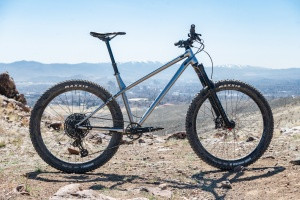 commencal meta ht am essential
commencal meta ht am essential
The Commencal Meta HT AM Essential truly impressed us with its versatility and fun-loving nature. This hardtail strikes an exceptional balance, performing admirably across a wide spectrum of terrain. Whether you’re tackling aggressive descents, flowing singletrack, or challenging climbs, the Meta HT AM delivers a dynamic and engaging ride.
Key Highlights:
- Versatile Geometry: The Meta HT AM boasts a geometry that’s aggressive enough for confident descending, yet not so slack that it becomes unwieldy on climbs or tighter trails. This balanced approach makes it a true all-rounder.
- Playful and Engaging: With its 27.5+ inch wheels (mullet or 29″ setup possible), moderate reach, and wheelbase, the Meta HT AM is incredibly playful. It encourages you to get airborne, manual through dips, and carve corners with enthusiasm.
- Capable Descender: Despite being a hardtail, the Meta HT AM handles surprisingly well on gnarly trails. The slackish front end and robust build inspire confidence when things get steep and technical.
- Efficient Climber: While not the lightest, the Meta HT AM climbs efficiently. Testers found themselves motivated to stand and power up climbs, thanks to the bike’s responsive feel.
- Exceptional Value: Commencal’s direct-to-consumer model shines through in the Meta HT AM Essential build. You get a high-quality component spec for the price, outperforming many competitors in this category.
Considerations:
- SRAM SX Eagle Drivetrain: While functional, the SRAM SX Eagle drivetrain is the entry-level option and not as refined as higher-tier groupsets.
- Mellow Trail Performance: The plus-sized tires and slack geometry, while great for versatility, can feel a bit less lively on very mellow trails compared to dedicated XC bikes.
Bottom Line: The Commencal Meta HT AM Essential is a top pick for riders seeking a versatile, fun, and capable hardtail that excels in a wide range of conditions. It’s a fantastic choice as a primary mountain bike or a robust addition to a quiver.
Read the Full Review of the Commencal Meta HT AM Essential
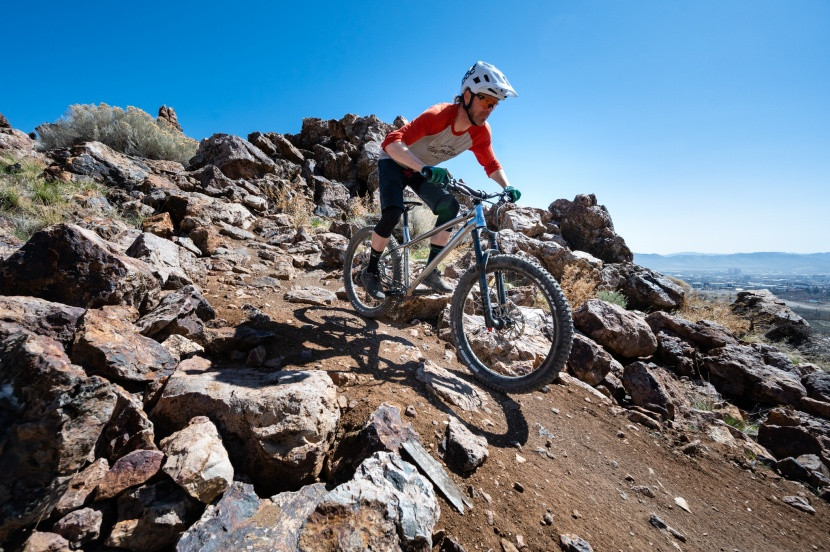 hardtail mountain bike – we took the meta ht into terrain where you wouldn
hardtail mountain bike – we took the meta ht into terrain where you wouldn
We pushed the Commencal Meta HT AM beyond the typical hardtail comfort zone, and it handled admirably.
Best Hardtail for Trail and Cross-Country Riding: Ibis DV9 NX
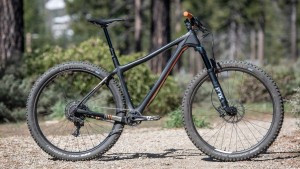 ibis dv9 nx
ibis dv9 nx
The Ibis DV9 NX stands out as a lightweight and efficient hardtail that excels on both trail rides and cross-country races. This bike prioritizes speed, agility, and climbing prowess, making it an ideal choice for riders who value efficiency and responsiveness on varied terrain.
Key Highlights:
- Exceptional Climbing and Acceleration: The DV9’s lightweight carbon frame and XC-oriented geometry translate to outstanding climbing efficiency and rapid acceleration. It feels incredibly quick and responsive under power.
- Sharp Handling: The bike’s geometry provides razor-sharp steering, making it highly maneuverable through tight corners and technical sections.
- Lightweight and Efficient: The carbon frame contributes to a low overall weight, enhancing both climbing and handling performance.
- Quality Components: Even with the budget-oriented NX build, Ibis smartly spec’d high-quality components where they matter most, including a great fork, tires, wheels, and a dropper post.
- Versatile Trail Capability: While primarily XC-focused, the DV9 is still capable on trail rides, offering a balance of efficiency and trail-worthiness.
Considerations:
- Stiff Ride: The lightweight carbon frame, while efficient, can transmit more trail feedback to the rider, resulting in a stiffer ride, especially on rough terrain.
- Less Forgiving on Rough Trails: The DV9 is best suited for experienced riders who can use proper technique to mitigate the stiffness on chattery trails.
- Not Ideal for Aggressive Terrain: While capable, the DV9 is not designed for the most aggressive downhill riding. Riders seeking a more downhill-focused hardtail should consider other options.
Bottom Line: The Ibis DV9 NX is an excellent choice for riders who prioritize speed, efficiency, and sharp handling. It’s perfect for cross-country racing, fast trail rides, and anyone seeking a lightweight and responsive hardtail.
Read the Full Review of the Ibis DV9 NX
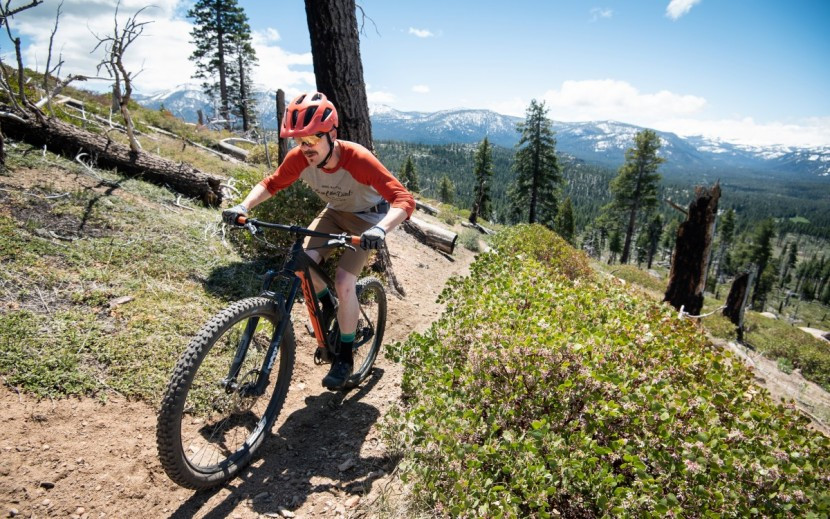 hardtail mountain bike – the dv9 is efficient and downright fast. it climbs like the wind and…
hardtail mountain bike – the dv9 is efficient and downright fast. it climbs like the wind and…
The Ibis DV9 NX is a speed demon, excelling at climbing and holding its own on descents.
Best Aggressive Hardtail: Rocky Mountain Growler 50
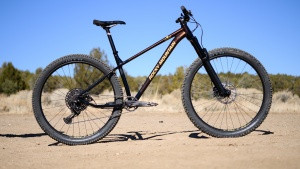 rocky mountain growler 50
rocky mountain growler 50
The Rocky Mountain Growler 50 is a hardtail built for riders who crave speed and challenging terrain. This bike embraces aggressive geometry typically found on enduro bikes, delivering exceptional stability and confidence when pushing the limits on descents.
Key Highlights:
- Enduro-Inspired Geometry: The Growler features a slack head angle, long reach, and wheelbase, creating a geometry that excels at high speeds and on steep, technical trails.
- Exceptional High-Speed Stability: The long wheelbase and slack geometry provide remarkable stability when bombing downhills, inspiring confidence at speed.
- Aggressive and Playful: Despite its length, the Growler remains playful and responsive. It loves to catch air and handle jumps and drops with composure.
- Confidence-Inspiring on Steep Terrain: The Growler’s geometry and robust build instill confidence on steep descents, allowing riders to tackle challenging terrain with control.
- Capable Climber (Surprisingly): While downhill-focused, the Growler climbs surprisingly well on mellow to moderate grades, thanks to a steep seat tube angle that positions you efficiently over the pedals.
Considerations:
- Technical Climbing Challenges: The long wheelbase and slack front end can make technical climbing more difficult, particularly in tight switchbacks.
- Awkward in Tight Spaces: The bike’s length can feel cumbersome in tight corners and maneuvering through slow, technical sections.
- Component Mix: The build kit features some strong points (tires), but some components, like the brakes, could be upgraded for more aggressive riding.
Bottom Line: The Rocky Mountain Growler 50 is the best hardtail for riders who prioritize descending prowess and aggressive trail riding. It’s a stable and confidence-inspiring machine that comes alive when pointed downhill.
Read the Full Review of the Rocky Mountain Growler 50
 hardtail mountain bike – the growler is a hardtail that features enduro-style geometry.
hardtail mountain bike – the growler is a hardtail that features enduro-style geometry.
The Rocky Mountain Growler 50 brings enduro bike geometry to the hardtail world, excelling on descents.
Best Hardtail for Versatility and Adventure: Marin Pine Mountain 2
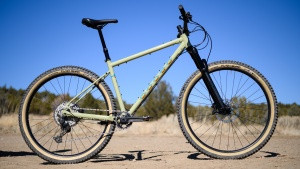 marin pine mountain 2
marin pine mountain 2
The Marin Pine Mountain 2 is a steel hardtail designed for versatility and adventure. This bike excels as a do-it-all machine, equally at home on trail rides, bikepacking trips, and exploring varied terrain. Its comfortable steel frame and thoughtful design make it a standout choice for riders seeking adaptability.
Key Highlights:
- Exceptional Versatility: The Pine Mountain 2 is incredibly versatile, handling trail riding, bikepacking, and general adventure riding with aplomb.
- Comfortable Steel Frame: The steel frame provides a smooth and compliant ride, absorbing trail chatter and enhancing comfort, especially on longer rides.
- Adventure-Ready Design: The frame is equipped with numerous mounts for racks, fenders, and accessories, making it ideal for bikepacking and loaded touring.
- Balanced Geometry: The Pine Mountain’s geometry is well-rounded, offering a comfortable pedaling position for climbing and confident handling for descents and cornering.
- Solid Component Spec: For the price, the Pine Mountain 2 boasts a robust build kit, including a reliable Shimano SLX 12-speed drivetrain and powerful 4-piston brakes.
Considerations:
- Heavier Weight: The steel frame contributes to a heavier overall weight compared to aluminum or carbon hardtails, which can be noticeable on climbs.
- Less Exciting Trail Bike: While capable on trails, the Pine Mountain is not as lively or performance-oriented as dedicated trail hardtails. It prioritizes versatility over outright trail shredding.
- Tire Specification: The stock tires, while adequate, could be upgraded for more aggressive trail riding.
Bottom Line: The Marin Pine Mountain 2 is the best hardtail for riders who value versatility and adventure. It’s a comfortable, capable, and adaptable bike that’s ready for everything from daily trail rides to multi-day bikepacking expeditions.
Read the Full Review of the Marin Pine Mountain 2
 hardtail mountain bike – the steel frame takes the edge off of chattery trails. steel is real.
hardtail mountain bike – the steel frame takes the edge off of chattery trails. steel is real.
The Marin Pine Mountain 2’s steel frame delivers a comfortable ride, perfect for long adventures and varied terrain.
How to Choose the Right Best Hardtail Mountain Bike for You
Choosing the best hardtail mountain bike ultimately depends on your individual needs and riding preferences. Consider these questions to guide your decision:
- What type of riding will you be doing primarily? (XC, Trail, Aggressive, Adventure)
- What kind of terrain do you typically ride? (Smooth trails, rough trails, technical descents, climbs)
- What is your budget? (Hardtails offer a range of price points)
- What frame material do you prefer? (Carbon for lightweight performance, Aluminum for balance, Steel for comfort and durability)
- What wheel size appeals to you? (27.5″ for agility, 29″ for speed and rollover, Plus sizes for traction and comfort)
- What components are important to you? (Drivetrain quality, brakes, suspension fork)
By carefully considering these factors and exploring the models highlighted in this guide, you’ll be well-equipped to find the best hardtail mountain bike to elevate your riding experience. Hardtails offer a unique and rewarding connection to the trail, and the right one can unlock new levels of fun and adventure.
[
